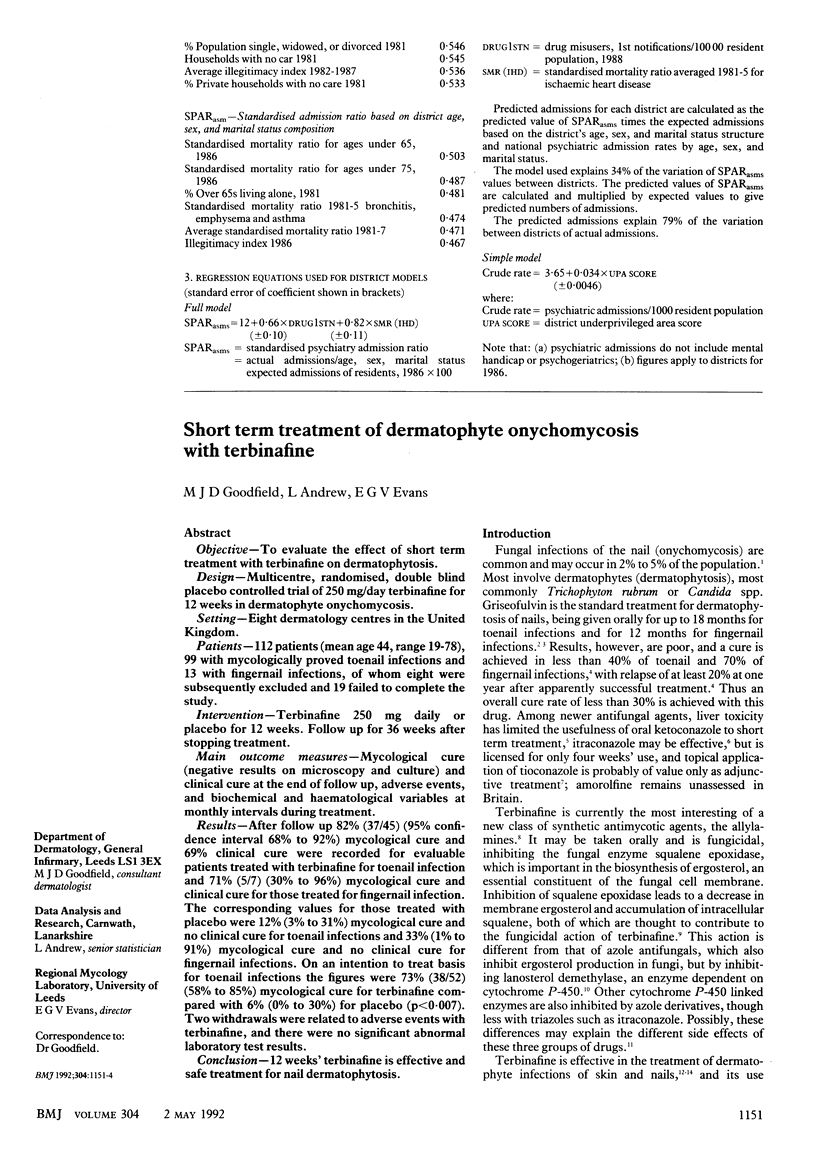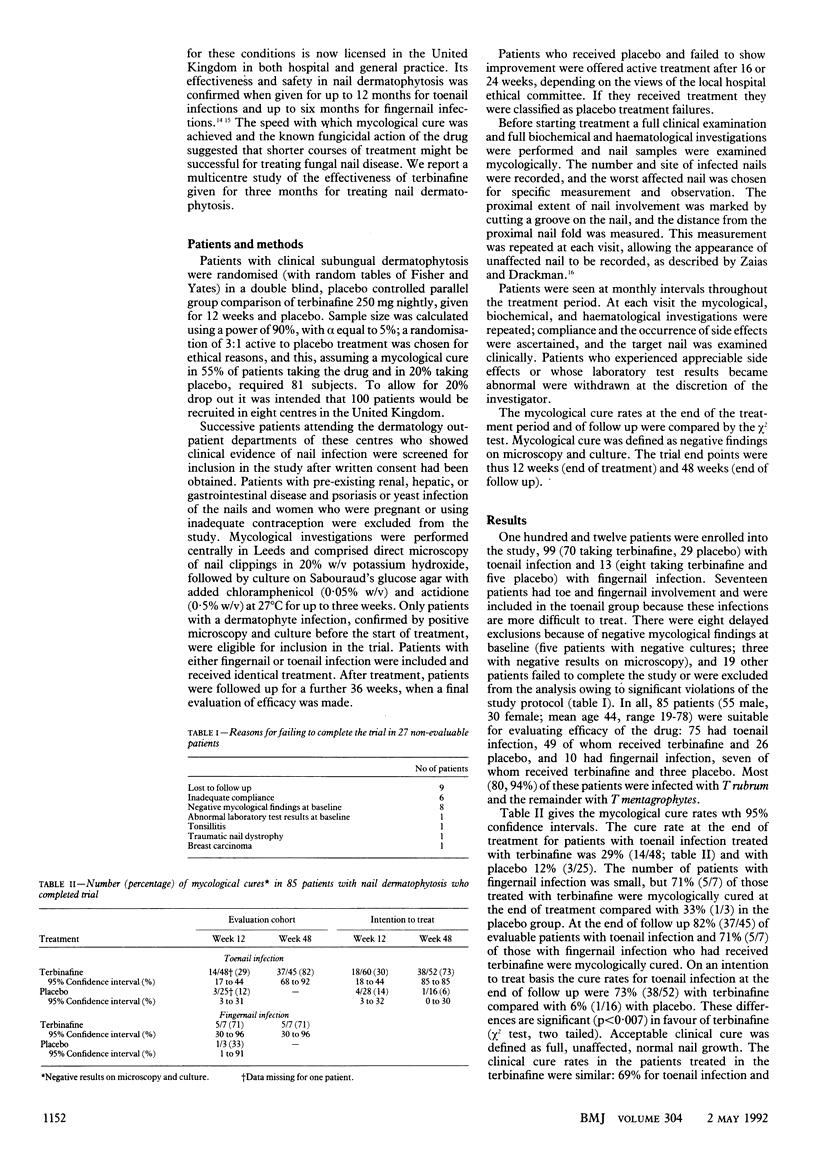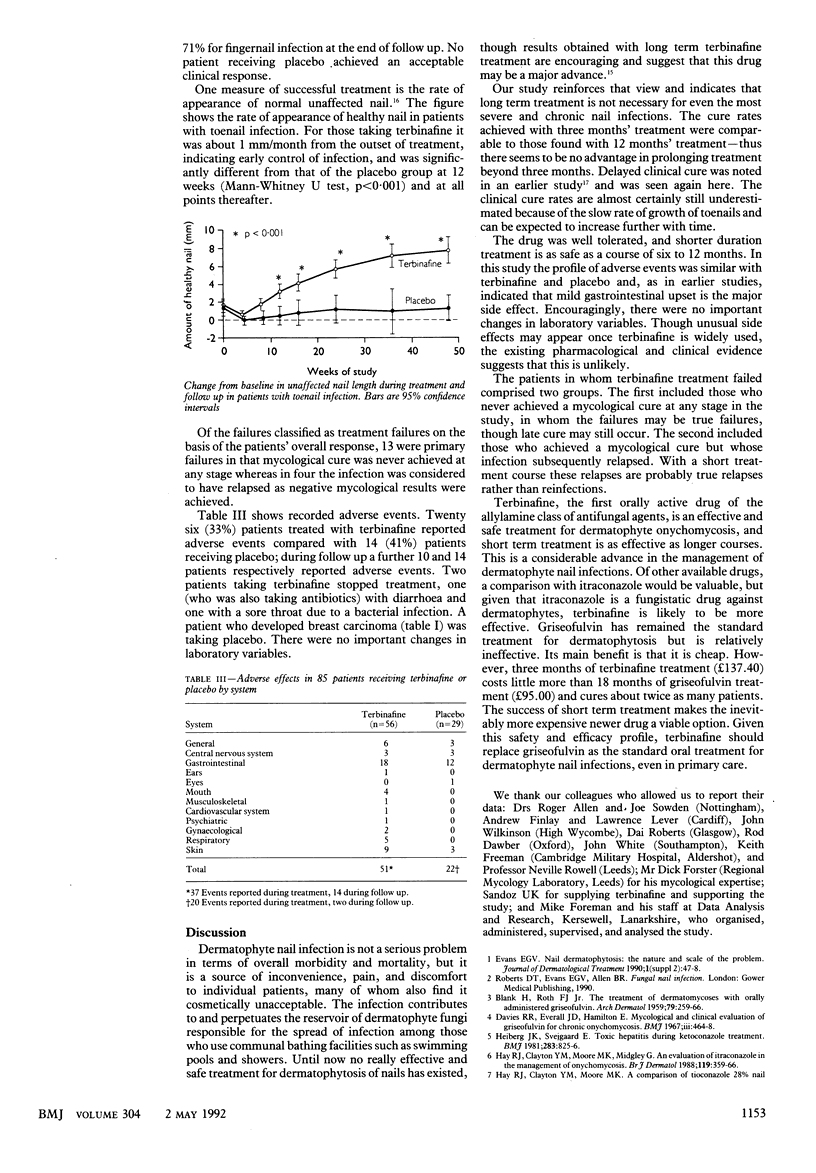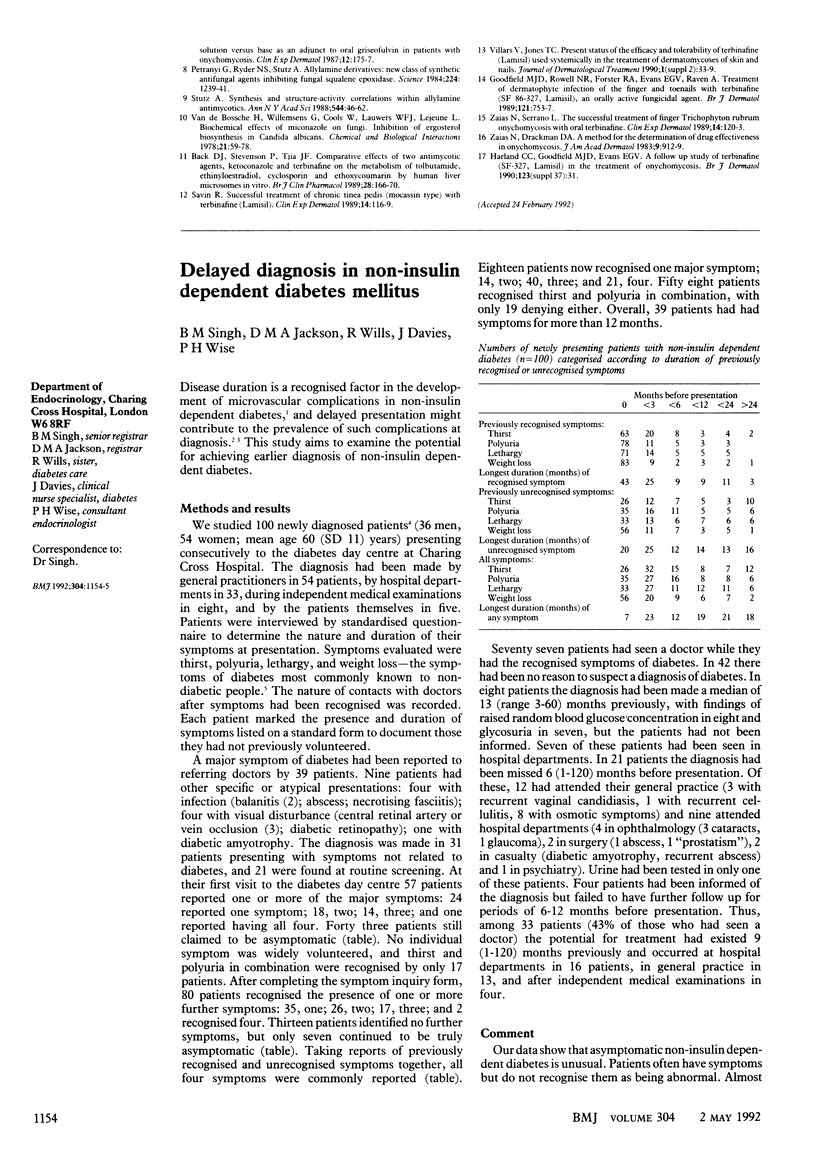Abstract
OBJECTIVE--To evaluate the effect of short term treatment with terbinafine on dermatophytosis. DESIGN--Multicentre, randomised, double blind placebo controlled trial of 250 mg/day terbinafine for 12 weeks in dermatophyte onychomycosis. SETTING--Eight dermatology centres in the United Kingdom. PATIENTS--112 patients (mean age 44, range 19-78), 99 with mycologically proved toenail infections and 13 with fingernail infections, of whom eight were subsequently excluded and 19 failed to complete the study. INTERVENTION--Terbinafine 250 mg daily or placebo for 12 weeks. Follow up for 36 weeks after stopping treatment. MAIN OUTCOME MEASURES--Mycological cure (negative results on microscopy and culture) and clinical cure at the end of follow up, adverse events, and biochemical and haematological variables at monthly intervals during treatment. RESULTS--After follow up 82% (37/45) (95% confidence interval 68% to 92%) mycological cure and 69% clinical cure were recorded for evaluable patients treated with terbinafine for toenail infection and 71% (5/7) (30% to 96%) mycological cure and clinical cure for those treated for fingernail infection. The corresponding values for those treated with placebo were 12% (3% to 31%) mycological cure and no clinical cure for toenail infections and 33% (1% to 91%) mycological cure and no clinical cure for fingernail infections. On an intention to treat basis for toenail infections the figures were 73% (38/52) (58% to 85%) mycological cure for terbinafine compared with 6% (0% to 30%) for placebo (p less than 0.007). Two withdrawals were related to adverse events with terbinafine, and there were no significant abnormal laboratory test results. CONCLUSION--12 weeks' terbinafine is effective and safe treatment for nail dermatophytosis.
Full text
PDF



Selected References
These references are in PubMed. This may not be the complete list of references from this article.
- BLANK H., ROTH F. J., Jr The treatment of dermatomycoses with orally administered griseofulvin. AMA Arch Derm. 1959 Mar;79(3):259–266. doi: 10.1001/archderm.1959.01560150001001. [DOI] [PubMed] [Google Scholar]
- Back D. J., Stevenson P., Tjia J. F. Comparative effects of two antimycotic agents, ketoconazole and terbinafine on the metabolism of tolbutamide, ethinyloestradiol, cyclosporin and ethoxycoumarin by human liver microsomes in vitro. Br J Clin Pharmacol. 1989 Aug;28(2):166–170. doi: 10.1111/j.1365-2125.1989.tb05410.x. [DOI] [PMC free article] [PubMed] [Google Scholar]
- Davies R. R., Everall J. D., Hamilton E. Mycological and clinical evaluation of griseofulvin for chronic onychomycosis. Br Med J. 1967 Aug 19;3(5563):464–468. doi: 10.1136/bmj.3.5563.464. [DOI] [PMC free article] [PubMed] [Google Scholar]
- Goodfield M. J., Rowell N. R., Forster R. A., Evans E. G., Raven A. Treatment of dermatophyte infection of the finger- and toe-nails with terbinafine (SF 86-327, Lamisil), an orally active fungicidal agent. Br J Dermatol. 1989 Dec;121(6):753–757. doi: 10.1111/j.1365-2133.1989.tb08217.x. [DOI] [PubMed] [Google Scholar]
- Hay R. J., Clayton Y. M., Moore M. K. A comparison of tioconazole 28% nail solution versus base as an adjunct to oral griseofulvin in patients with onychomycosis. Clin Exp Dermatol. 1987 May;12(3):175–177. doi: 10.1111/j.1365-2230.1987.tb01888.x. [DOI] [PubMed] [Google Scholar]
- Hay R. J., Clayton Y. M., Moore M. K., Midgely G. An evaluation of itraconazole in the management of onychomycosis. Br J Dermatol. 1988 Sep;119(3):359–366. doi: 10.1111/j.1365-2133.1988.tb03229.x. [DOI] [PubMed] [Google Scholar]
- Heiberg J. K., Svejgaard E. Toxic hepatis during ketoconazole treatment. Br Med J (Clin Res Ed) 1981 Sep 26;283(6295):825–826. doi: 10.1136/bmj.283.6295.825. [DOI] [PMC free article] [PubMed] [Google Scholar]
- Petranyi G., Ryder N. S., Stütz A. Allylamine derivatives: new class of synthetic antifungal agents inhibiting fungal squalene epoxidase. Science. 1984 Jun 15;224(4654):1239–1241. doi: 10.1126/science.6547247. [DOI] [PubMed] [Google Scholar]
- Savin R. Successful treatment of chronic tinea pedis (moccasin type) with terbinafine (Lamisil). Clin Exp Dermatol. 1989 Mar;14(2):116–119. doi: 10.1111/j.1365-2230.1989.tb00906.x. [DOI] [PubMed] [Google Scholar]
- Stütz A. Synthesis and structure-activity correlations within allylamine antimycotics. Ann N Y Acad Sci. 1988;544:46–62. doi: 10.1111/j.1749-6632.1988.tb40388.x. [DOI] [PubMed] [Google Scholar]
- Zaias N., Drachman D. A method for the determination of drug effectiveness in onychomycosis. Trials with ketoconazole and griseofulvin ultramicrosize. J Am Acad Dermatol. 1983 Dec;9(6):912–919. doi: 10.1016/s0190-9622(83)70208-2. [DOI] [PubMed] [Google Scholar]
- Zaias N., Serrano L. The successful treatment of finger Trichophyton rubrum onychomycosis with oral terbinafine. Clin Exp Dermatol. 1989 Mar;14(2):120–123. doi: 10.1111/j.1365-2230.1989.tb00907.x. [DOI] [PubMed] [Google Scholar]
- van den Bossche H., Willemsens G., Cools W., Lauwers W. F., Le Jeune L. Biochemical effects of miconazole on fungi. II. Inhibition of ergosterol biosynthesis in Candida albicans. Chem Biol Interact. 1978 Apr;21(1):59–78. doi: 10.1016/0009-2797(78)90068-6. [DOI] [PubMed] [Google Scholar]


